
Travel Guide
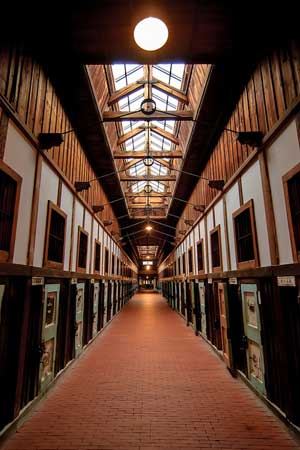 Introduction
Introduction
Abashiri Prison Museum is originally the Abashiri Prison, which was one of Japan's first-ever maximum security prisons, has been holding Japan’s most dangerous criminals since the 1890s. Abashiri Prison was established with a mandate to use the prisoners as laborers in the expansion and development of land in Hokkaido.
Abashiri Prison was constructed to hold more than one thousand dangerous criminals. The prison gained national fame through a popular yakuza movie series by director Ishii Teruo in the 1960s. Following a major modernization of the Abashiri Prison in 1984, the prison's old buildings were moved into the Abashiri Prison Museum, which opened its doors to the public in 1985 as an open air museum. Note that the modernized Abashiri Prison is still in operation at the foot of Mount Tento-zan.
For almost a century, the town of Abashiri in north-eastern Hokkaido was the location of Japan's most notorious and most feared prison. Only the most hardened criminals were brought to this forbidding place on the Okhotsk Sea where the harsh winters bring the Siberian drift ice to the shore. The work was hard, the cells crowded and the wardens were strict and did not tolerate even the tiniest infractions of the rules.
In this museum, the buildings that were actually in use in the Meiji era have been kept and shown to the public. The museum is massive and take at least two hours to see completely. There are 22 building areas in all; some have been completely restored while others are reproductions. The oldest building was built more than 100 years ago. In those days, construction wood was made by hands, not by machines so you can see the rough surface of the big beams and pillars that the prisoners made.
Visitors can walk through the agricultural processing areas, solitary confinement, barracks and administration buildings. Perhaps most impressive is the radial five-winged prison modeled after a similar Belgian prison with its guard house located at the center, allowing every wing to be monitored at the same time. One of the buildings contains the tools that the Abashiri prisoners used to build roads and stuff. In this same building, visitors can watch a video clip depicting the harsh conditions they had to go through, back in the old days.
The Abashiri Prison Museum illustrates the daily life of prisoners and there are many life-sized dolls placed in the key locations to "re-enact" the way life was back in those days.
In front of the main gate, you will find a souvenir shop. At the souvenir shops wooden goods made by the current Abashiri prisoners – from small handicraft dolls to furniture - can be bought.
Attractions
Mirror Bridge
There is the Mirror Bridge, originally leading over the Asahikawa River. The name of the bridge is said to derive from the fact that the prisoners could see their own reflections in the water of the river. The faces of guilty men when they entered, the faces of reformed men when they left. If they ever left, that is. But that whole mirror face business sounds a bit too much like sentimental government propaganda to be truly believed.
The former Mirror Bridge is now a concrete bridge not affording much of a mirror image if you look down towards the water. Prisoners are transported by bus or van these days anyway, so the bridge would not make much of an impression on them. But you as a free person can walk over it and to the central gate. It seems however more like being a gate for show - the actual entranceway into the prison for the inmates is more likely some un-ceremonial truck gate somewhere in the back.
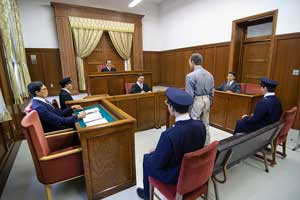 District Court
District Court
There is a court house for local offenders, there are reconstructions of temporary lodging houses out on the farms (which do not look comfortable at all!) and of the separate windowless arrest cells for offenders breaking the rules. Not exactly nice places but offenders stayed there for a maximum of 7 days.
Prison Cells
Among the structures in the museum are prison cells from the ancient days. Visitors can enter some of them and get an idea of how it feels to be locked up… The wooden bars of each cell are slanted in a way that prevents prisoners from different cells to see each other. Modern prison cells are also displayed. Visitors who envision prison cells as dark and gloomy will be surprised, as they’re neat and clean, furnished with books and a TV set to boot, among other amenities.
Bath House
There is a big bath house. Bathing was the one pleasure the inmates were granted once a week - with cold water in the summer and hot water in the winter. On the one hand to prevent skin diseases from spreading, on the other to give the inmates a sort of release every once in a while. Something they could look forward to.
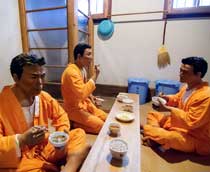
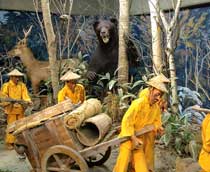
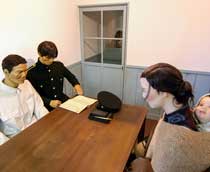
Travel Advice
The history of the Abashiri Prison
When the Edo era ended and the Meiji era began, men cropped their topknots and wore their hair bobbed. Less and less people wore swords. In winter, the ocean near the village was frozen. So the life was hard for the pioneers. Ten years passed, and the number of people who remain in the village in winter finally started to increase. That was what Abashiri was like at that time.
In 1890, the borders in East Asia were still not clearly defined. Japan claimed Hokkaido but the Meiji government was afraid that imperial Russia would march into the northern part of the island which was still in a state similar to Siberia. At that time, Russia has stepped away to build the Trans-Siberian train line to the far east or close to the tip of Hokkaido Island. There was not much else other than a few fishing villages and vast expanses of forests populated by bears in Hokkaido at that time.
To prevent the invasion of Russia, the government decided to build a road in Hokkaido as supply lines and weaponry. The problem is, when the government does not have enough money to carry out the construction.
Meiji Government Secretary, Kentaro Kaneko, then proposed the idea to the government to utilize inmate labor. In a letter quoted guidebook Abashiri Prison Museum, Kaneko wrote, “Hokkaido is still underdeveloped and need to be expensive to build roads. By utilizing inmates, we can complete the construction at a cost much cheaper. If prisoners die during the process, we are spending to take care of prisoners was reduced. Once paddle, two islands exceeded, “said Kentaro as quoted guidebook Abashiri Museum.
The proposal was accepted.
One day, a government official with a fine beard came to the village. The official walked around the village and then climbed a mountain. And the found a spot he was looking for. On the north here was the Sea of Okhotsk, and Lake Abashiri was on the south. Lake Notori lied on the Westland a big river drifted at the foot of the mountain. “Oh, great. This is it! It is hard to escape from here. And it is easy for us to keep an eye on them.”
This land had to be quickly developed and connected to the settled parts of Hokkaido. Thus one month later, in the spring of 1890, a first batch of prisoners was dispatched to the strategically located fishing village of Abashiri. The prisoners came from all over Japan and their first task was to build a road connecting Abashiri to an already developed outpost close to Asahikawa in Central Hokkaido. The men cut down big trees in the forest near the river, following the instruction of their watchman. Then they built a hut for themselves using the trees they cut down. Next month, fifty more men came to the village with their hands and legs chained together.
The road work was extremely hard. Everything had to be done by hand. The trees felled, the terrain cleared, the road constructed, the bridges built, while food was scarce, accidents very common and on top of it, every prisoner had a heavy iron ball chained to a foot to prevent them from disappearing into the wilderness. Working through the extreme cold of the Hokkaido winter, the road was finished in record time. Japan could now rightfully claim Northeast Hokkaido as her land.
The death toll among the prisoners was extremely high. At the time, they were seen as expendable human resources but the museum now has a special hall built to commemorate them. A dramatic movie is shown there, plenty of pictures demonstrate their plight and yes, you can chain an iron ball to your leg and walk a few steps with it. Certainly an interesting experience for a minute or two but imagine wearing this thing 24 hours a day while doing extremely exhausting and dangerous road building work out in the primal forest!
The inmates are frustrated burn the prison in 1909. The government then rebuilt the prison in 1912. This new prison that is now a museum.
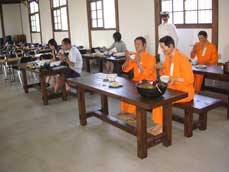 Prison Food
Prison Food
Visitors can try out some real prison food in the museum’s canteen - the actual food that the current Abashiri prisoners eat. Lunch Set A consists of broiled barley and rice, grilled mackerel pike, some vegetables and miso soup. Lunch Set B is similar, except instead of mackerel pike, Atka mackerel is served instead.
Prison Movies
Many films have been made about Abashiri prison.
Doing Time (Yoichi Sai, 2002) gives you a peek at daily life in the new prison as it is today. It was filmed on location inside the prison. Read a review here.
Great fictional drama playing out in the old prison can be seen in Abashiri Bangaichi by director Teruo Ishii, made in 1965. This film started a long series of Abashiri prison films under the same title, while at the same time kick-starting the career of actor Ken Takakura.
Gosunkugi Torakichi
Gosunkugi Torakichi, the nickname for the man named Torakichi Nishikawa, was considered the king of prison escapes during the Meiji Period, earned his nickname, which means “Long Nail,” after one particularly dramatic escape attempt. In the middle of one of his six break outs, he accidentally stepped on a nail 15 centimeter (about 5.9 inches) long–and then pulled it out and ran for about 12 kilometers (7.456 miles).
The escape artist calmed down later in life and became a model prisoner. He was even entrusted with cleaning the area outside of the gate. In his later years, he was eventually paroled and spent the rest of his life going around the country, sharing his stories.
However, Gosunkugi wasn’t the only escape artist to have spent time in Abashiri Prison. While Gosunkugi was the king of prison escapes in the Meiji period, Yoshie Shiratori held that crown during the Showa period (1926-1989).
Yoshie Shiratori
Yoshie Shiratori (白鳥 由栄 Shiratori Yoshie, July 31, 1907 - February 24, 1979) was a Japanese national born in Aomori Prefecture. He had one daughter. He was known as the “Prison Break Magician of the Showa Era” for having escaped from prison four times over three years. In total he was sentenced to life plus 23 years for his crimes but only served 26 years and was paroled in 1961.
Shiratori was said to have superhuman strength and is alleged to have run 120 kilometers (74.6 miles) in one day, in addition to snapping apart his handcuffs…with his bare hands. In addition, it is said that he was able to dislocate his joints and could slide through an opening no bigger than the size of his head.
In 1933 he was apprehended on suspicion of a murder and robbery he had allegedly committed with some accomplices. Prosecutors sought the death sentence but he escaped from Aomori prison in 1936 after using a length of wire to pick the lock on his handcuffs. He was soon recaptured and sentenced to life imprisonment. He escaped from Akita prison in 1942 by fleeing through an air vent in the prison's ceiling. After he was rearrested again three years were added to his sentence and he was incarcerated in Abashiri Prison. In 1944 he weakened his handcuffs and the inspection hole on his cell door by rusting them with miso soup and escaped. After World War II, he injured a man and the man later died. He was arrested again in 1946. Sapporo District Court sentenced him to death but in 1947, while awaiting execution in Sapporo Prison, he escaped by sawing through the floorboards of his cell with a sharpened piece of sheet metal then digging his way to freedom with a bowl.
Finally, in 1948 at the age of 41, Shiratori was exhausted and after receiving a cigarette from a police officer admitted that he was an escaped convict. The high court dismissed the murder allegation and revoked his death sentence instead sentencing him to 20-years in prison. He stayed in jail after that until he was paroled in 1961. He went to Aomori Prefecture in 1973 and he met with his daughter but he didn't speak to her. He died of a heart attack in 1979. His ashes were taken by a woman who was caring for by him.
Shiratori’s prison breaks were infamously known that it made it to the big screen in 1965 in a movie titled Abashiri Bangaichi (A Man from the Abashiri Prison). In 1983, a novel based on Shiratori’s life, Hagoku (literally, Prison Break), was published by Akira Yoshimura. And the book was adopted in 1985 into a made-for-TV movie by NHK, the Japan Broadcasting Corporation.
Prison life
In a wooden house dozens of people crammed scramble remaining warmth. Winter in early February is completely frozen. The temperature can be dropped quickly to minus 18 degrees Celsius. If dozens of people were not the sculpture, they would freeze to death before the snow stops.
In the prison, first, hundreds of prisoners against the cold so as not to freeze to death only with thin pajamas and thick blanket used together.
In the wooden house had no heating so the cold wind to freely enter the room, slipped under the covers, and chilled to the bone plunged inmates. There’s nothing they can do but wait it’s freezing night until morning. Outside the house, the guard standing upright with arms. The scene was made in detail in the form of a diorama with nearly resemble the original size
When the noon comes, the prisoners were led to the construction project along Road Chuo-Doro 200-km line linking central and eastern Hokkaido. They also deployed to complete the expansion and construction of government buildings. In a sense, the prisoners who built Hokkaido. At that time, the island is still filled with heavily logged forest and a variety of animals.
Although the energy is used up, the supply of food to prisoners was minimal, with only a small bowl of miso soup, rice, a small piece of fish, and a dash of vegetable. Health is ignored. They can only shower 1-2 times a month at a public bath guarded. Time for a shower just a few minutes. “The guard will give the cue to the prisoner to soak in the tub. Then tell them to get out of the tub, soaped, then rinse. Recently they were told to wipe the body. The event finished bathing, and then they go back to jail.
Although only a few minutes, the bath was very eagerly awaited prisoner. Because, if you do not get a chance bath, their skin will be depleted encroached scabies and other skin diseases. Such a fate befall many inmates-inmates sentenced to months in isolation.
With such treatment, many inmates are not strong and eventually die. Guidebook issued Abashiri Prison Museum, The Largest and Oldest Prison Museum in Japan, said, in a short time, 221 prisoners died due to exhaustion, malnutrition, and can not stand up to the rigors of nature Abashiri. Prisoners who died directly buried in the sides of the road along the 200 kilometers of newly built.
With a reputation like that, Abashiri Prison became the most haunted prison and feared throughout Japan.
Visit
| Address | 1-1 Yobito, Abashiri-shi, Hokkaido | |
| Phone | 0152-45-2411 | |
| Admission | Adult: 1,100 yen Student: 770 yen Child: 550 |
Adult: over 22 Student: 16 to 21 Child: 6 to 15 Groups: over 25 20% off for group over 20 |
| Hours | 08:30 to 18:00 July to September 09:00 to 17:00 October to Jun |
Entry until 1 hour before closing |
| Closed | Open 7 Days a Week | |
| Duration | 40 minutes | |
| Getting There | By Train 40 minutes ride on the general routes "Attraction Route" by Abashiri Bus from JR Abashiri Station to the Abashiri Prison Museum bus stop, then walk approximately 1 minute. 40 minute walk or 7 minutes ride by car from Abashiri Station on the JR. By Car Take Bihoro Bypass to the Memanbetsu exit and take National Highway route 87. It is approximately 18 kilometers 30 minutes from exit. |
|
| Parking | Parking available | |

